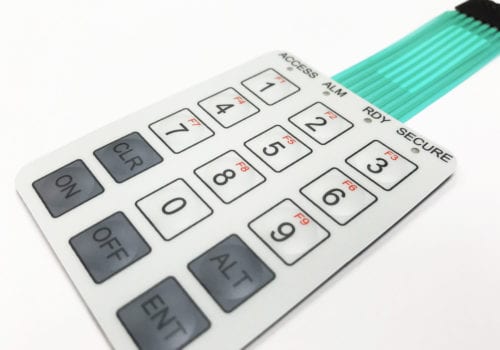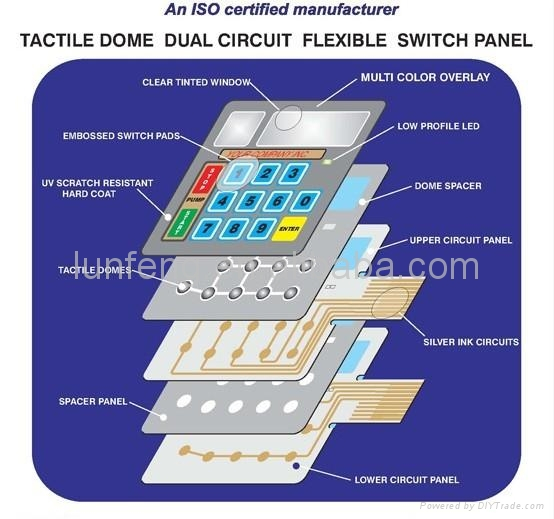Membrane Switches: A Cost-Effective Solution for Product Interfaces
Membrane Switches: A Cost-Effective Solution for Product Interfaces
Blog Article
Recognizing the Significance of Membrane Switches in Interface
Membrane switches are important components in the layout of efficient individual interfaces, assisting in not just performance yet also improving visual appeal and customer interaction. Their one-of-a-kind attributes, such as resistance to environmental variables and adjustable layouts, make them suitable for a varied array of applications across numerous industries. As we check out the various advantages and future fads connected with Membrane technology, it ends up being clear that these buttons are more than simply parts; they represent a convergence of technology and practicality. The ramifications of this modern technology on user experience are worth taking a look at further.
What Are Membrane Buttons?

The spacer layer, which has sticky residential properties, enables the separation of the circuit layer from the overlay, guaranteeing that the switch continues to be in a non-activated state up until pressed. When pressure is put on the overlay, it compresses the spacer layer, bridging the void and finishing the circuit in the underlying layer. This style not only lowers the physical area required for traditional mechanical buttons but also boosts the toughness of the device, as Membrane switches are generally immune to dust, wetness, and other environmental elements.
Frequently located in applications varying from consumer electronic devices to clinical devices, Membrane switches are indispensable to contemporary technology, giving a efficient and straightforward interface that straightens with contemporary layout needs.
Advantages of Membrane Switches
While many switch innovations exist, Membrane Switches offer distinct benefits that make them especially preferable in various applications. Among the key benefits of Membrane buttons is their small layout, which allows for space-saving executions in devices where genuine estate is restricted. Their thin profile not just enhances aesthetic allure but likewise promotes lightweight building and construction.
Another considerable benefit is their resistance to ecological factors. Membrane buttons are typically sealed versus dampness, dust, and contaminants, making them suitable for usage in demanding environments, such as medical gadgets and commercial tools. This resilience prolongs the life-span of the button, reducing maintenance expenses and improving dependability.
In addition, Membrane switches can be customized to meet particular style demands, including one-of-a-kind graphics and colors that enhance user interaction. Their tactile comments choices can likewise be customized to supply an enjoyable customer experience. Additionally, Membrane switches are cost-effective, particularly in high-volume applications, as they can be produced effectively.
Applications in Numerous Industries

In the customer electronics industry, Membrane switches are prevalent in tools such as microwaves, washing machines, and remotes. Their tactile feedback and visual options boost individual experience while providing a smooth, modern appearance. Additionally, auto makers utilize Membrane switches in control panel controls and infotainment systems, where area is restricted, and individual involvement is important.
Moreover, the commercial sector leverages Membrane buttons in control panels for machinery and tools, allowing for user-friendly operation in typically rough atmospheres. Their resistance to chemicals and dampness guarantees longevity and integrity in these applications. Generally, the adaptability of Membrane Switches contributes significantly to their extensive usage, making them indispensable in various technical domains.
Design Factors To Consider for Membrane Switches

When creating Membrane switches, numerous vital considerations should be considered to make certain optimal functionality and individual experience. First of all, the option of products is essential; selecting resilient, premium substratums can improve the button's durability and resistance to ecological aspects such as dampness and temperature level variations.
Secondly, the design of the visuals overlay need to focus on clearness and simplicity of use. Icons and message have to be readable, and the design ought to help with intuitive communication (membrane switches). In addition, responsive comments is important; incorporating a responsive dome or various other mechanisms can enhance the customer experience by supplying physical confirmation of activation
Another vital aspect is the switch's electric efficiency. Designers have to ensure that the conductive traces are effectively created to minimize resistance and stay clear of signal disturbance. This involves analyzing the needed actuation force and making certain compatibility with the electronic components they will certainly interface with.

Future Trends in Membrane Modern Technology
As innovation remains to advancement, Membrane switches are positioned to advance substantially, driven by innovations in materials and making techniques. One arising fad is the consolidation of innovative materials, such as flexible substrates and conductive inks, which boost resilience and minimize the total weight of Membrane switches. These products not just improve the advice tactile action yet also enable the layout of buttons that can endure harsher environmental problems.
In addition, the integration of touch-sensitive innovations is changing typical Membrane Switches into more interactive interface. Capacitive touch sensing units installed within Membrane button panels can give a more responsive and user-friendly customer experience, straightening with the growing demand for sleek, contemporary styles in consumer electronics.
Furthermore, improvements in view website printing strategies, such as electronic and 3D printing, make it possible for quick prototyping and modification of Membrane buttons. This adaptability permits suppliers to react more quickly to market demands and customer choices.
Last but not least, sustainability is coming to be a substantial emphasis, with suppliers discovering environmentally friendly materials and processes. As these fads unfold, the future of Membrane technology promises enhanced capability, aesthetic allure, and environmental obligation, solidifying their role in innovative interface throughout numerous markets.
Final Thought
To conclude, Membrane Switches stand for a crucial part in the layout of customer interfaces, integrating performance with aesthetic adaptability. Their advantages, including durability and resistance to ecological aspects, make them appropriate for varied applications throughout various industries. In addition, thoughtful style considerations boost individual communication and experience. As developments in technology proceed, the evolution of Membrane switches is anticipated to further improve individual interfaces, driving technology and enhancing usability in a significantly complex technical landscape.
Membrane buttons are indispensable components in the style of reliable user interfaces, assisting in not just functionality however likewise boosting aesthetic appeal and individual see post communication.Membrane Switches serve as an important part in numerous user interfaces, helping with a seamless communication in between customers and electronic devices.While various button modern technologies exist, Membrane Switches deal distinct advantages that make them particularly desirable in different applications.Additionally, Membrane buttons can be tailored to fulfill specific design requirements, incorporating distinct graphics and colors that improve individual interaction.In final thought, Membrane Switches represent an important component in the design of user interfaces, combining functionality with aesthetic flexibility.
Report this page